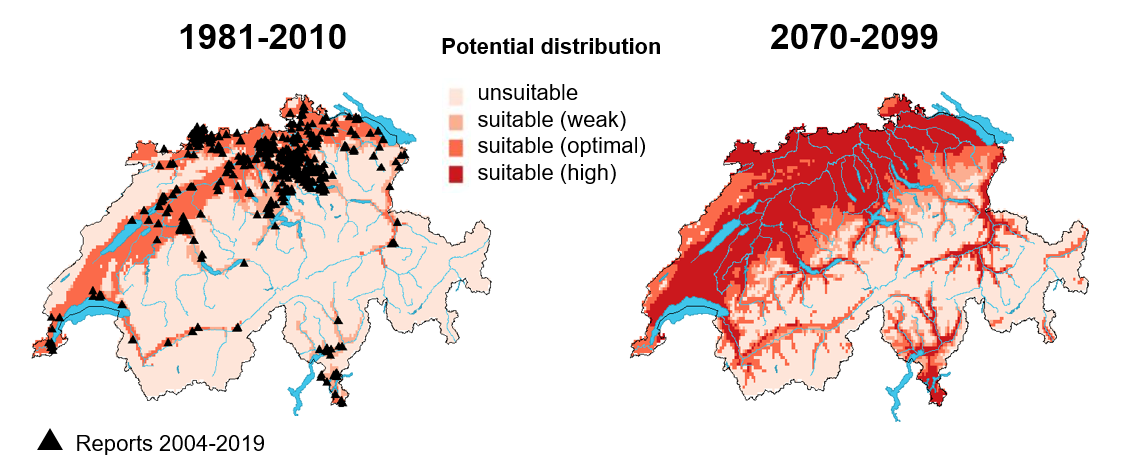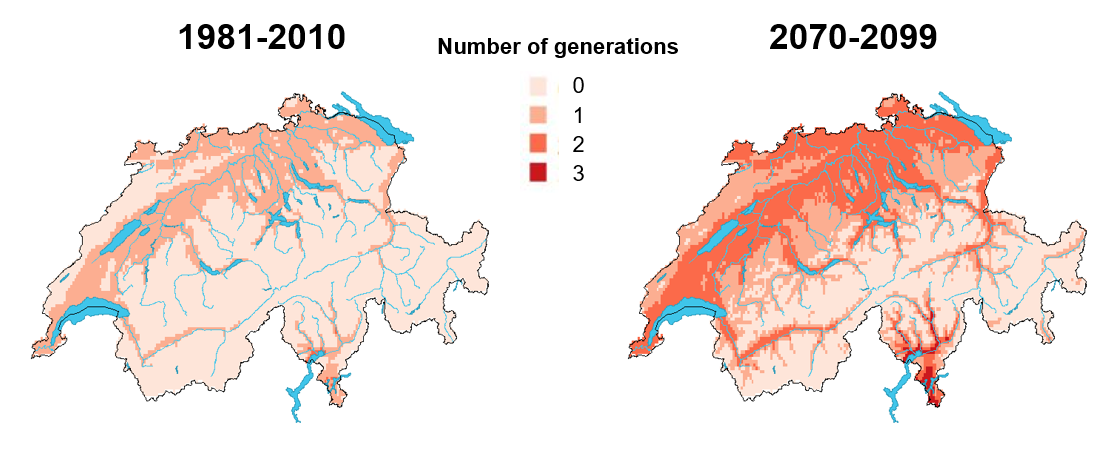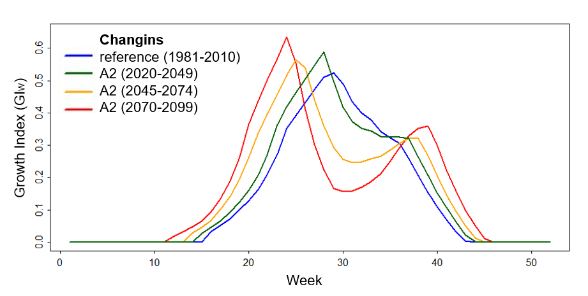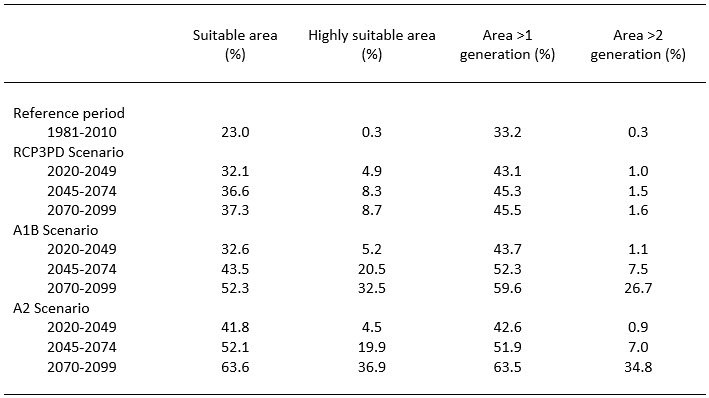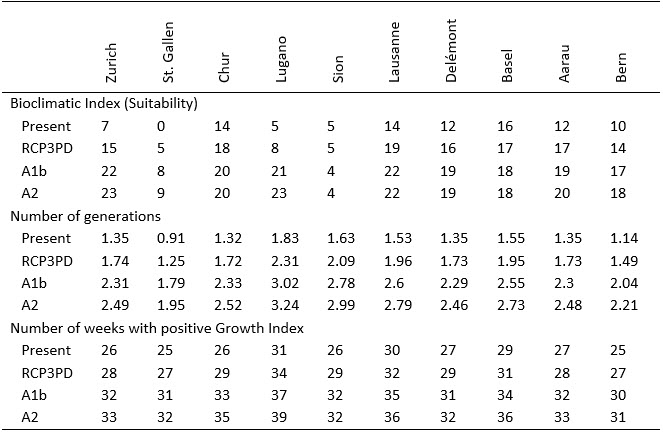The marmorated stink bug (Halyomorpha halys) (Heteroptera: Pentatomidae) (Figure 1) originates from East Asia and selects from over 200 wild or cultivated forage plants (Lee et al. 2013). It infests almost all fruit species (e.g. pears, cherries, peaches, raspberries), vegetables (e.g. tomatoes, cucumbers, peppers), but also field crops such as corn and soya (Leskey and Nielsen 2018). It is 12 to 17 mm long and is marked by five yellow dots below the neck label (Wyniger and Kment 2010). The belly side is light and has a few black dots at the edges. The marmorated stink bug hibernates as an adult bug and is active from April to October from a temperature of 10-15°C (Leskey and Nielsen 2018). South of the Alps usually two generations develop, e.g. in Italy (Costi et al. 2017), north of the Alps one generation can be observed (Haye et al. 2014). However, there is clear evidence that the marmorated stink bug has also produced two generations in the warm year (e.g. 2018) in northern Switzerland. For hibernation in autumn, the bug seeks sheltered places on walls or in buildings. Therefore, the marmorated stink bug can also become a plague in the settlement area in autumn. Caution, if you squeeze this "stink bug" too hard, it will secrete a stinking secretion.
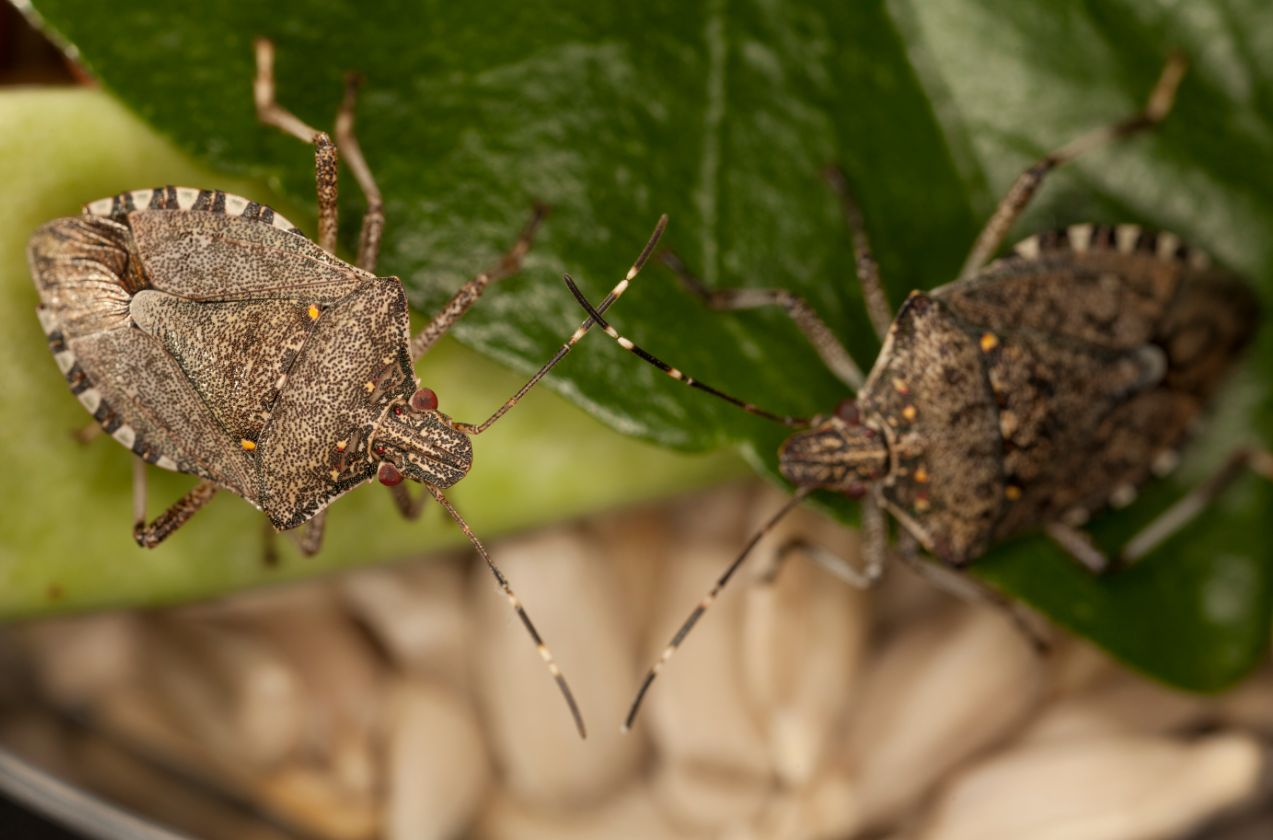
© Agroscope (Arnaud Conne)
The marmorated stink bug was introduced into the USA at the end of the 20th century and quickly developed into a major pest in apple, peach and corn in the northeast of the USA (Hoebeke and Carter 2003; Leskey et al. 2012). In Europe, the oldest record of 2004 comes from the district of Hottingen in Zurich (Haye et al. 2015). In the meantime it can already be found in most European countries (Claerebout et al. 2019). In 2015, the marmorated stink bug caused massive damage to pear crops in Italy (Emilia Romagna) (Costi et al. 2017). In Switzerland, the marmorated stink bug was initially restricted to the cities of Zurich, Basel, Bern and Lugano, because it finds suitable conditions there. In recent years, however, it has spread over large parts of Switzerland, including the Central Plateau, the areas around Basel and between Bern and Lake Geneva, Ticino and also Valais. In addition, overwintering individuals often cover longer distances as stowaways in cars or freight boxes. In Ticino, the first serious damage to peaches and pears was reported in 2015, and damage to fruit crops in northern Switzerland was also reported for the first time in 2017. In particular, the damage reports from 2018 and 2019 showed that the marmorated stink bug has become a dangerous insect for special crops in many regions of Switzerland.
The development of an effective control strategy is difficult because the marmorated stink bug infests many plant species, colonises numerous habitats and is extremely mobile. It is also resistant against plant protection products. In Switzerland, no pesticides against the bug have yet been approved. Various control measures such as exclusion netting, cultivation techniquesand use of natural antagonists, attract-and-kill strategies with trap crops or plant protection products are currently being tested worldwide (Leskey and Nielsen 2018; Morrison et al. 2019). In 2017, a small parasitic wasp was first found in Ticino, which infests the eggs of the bug. This Samurai wasp, native to Asia, is promising for biological control of the marmorated stink bug (Stahl et al. 2019). An important part of a control strategy is monitoring. Since 2012, CABI Delémont has been operating a web platform with information and reported occurrence records. Since 2017, Agroscope coordinates a national monitoring of the occurrence and development of the marmorated stink bug in agriculture. Optimised monitoring with a mobile app is also the aim of the Interreg Upper Rhine project « InvaProtect ».
The current distribution of the marmorated stink bug in Switzerland was recorded by means of find reports from private households between 2004 and 2019 (about 500 reports). The potential distribution and seasonal occurrence of the marmorated stink bug under present and future climatic conditions in Switzerland was estimated bioclimatically using the CLIMEX model (Kriticos et al. 2015). The simulations are based on the model parameters specifically tested for the marmorated stink bug (Kriticos et al. 2017) and on the climate scenarios for Switzerland. The model estimates how suitable a location is for the long-term survival of the bug.
The find reports correspond very well with the simulated potential distribution area of today (Figure 2). The comparison also shows that under today's climate conditions most of the potentially suitable areas are populated (Stoeckli et al. 2020).
According to our simulation with the CLIMEX bioclimatic model and local climate scenarios for Switzerland, the potential range of the marmorated stink bug is likely to expand further in the future (Figure 2) (Stoeckli et al. 2020). By 2099, the marmorated stink bug could find suitable living conditions throughout northwestern Switzerland. In addition, the potential area of distribution in the south of Switzerland is likely to shift to fruit-growing areas at higher altitudes. By 2099, 63.6% of the total area of Switzerland would thus be climatically suitable for long-term settlement of the bug (Table 1; Strongest climate scenario A2, 2070-2099). Compared with today's 23.0%, the potential distribution area would thus almost triple. If the reduction scenario RCP3PD is applied, the potential distribution area could increase by about 10%. Up to the year 2045, the estimated impacts are similar for all three climate follow-up models (Table 1). The simulations also show that with the A1B and A2 scenarios the potential range increases by more than 10% in each time period. With the mitigation scenario, an increase of only 0.7% can be expected from 2045 to 2099. In the case of a very high suitability potential, a very strong dispersion and a very high population size must also be expected. This proportion of land is currently minimal at 0.3% (Table 1). With the A1B and A2 scenarios, the proportion of land with very high suitability potential could increase to 32.5% and 36.9% respectively by 2099.
The bioclimatic simulations confirm that under current climatic conditions the marmorated stink bug can produce one generation in northern Switzerland and two generations in southern Switzerland (Figure 3). However, a detailed analysis of individual years showed that in warm years, such as 2018, two generations can also occur in northern Switzerland. Under today's climatic conditions, the marmorated stink bug can produce one generation on 33.2% of the area of Switzerland. With the A2 scenario, this proportion could rise to 63.5% by 2099 (Table 1) (Stoeckli et al. 2020). An additional generation must also be expected in the future. This means that the marmorated stink bug in Switzerland could regularly produce two, possibly even three generations. The proportion of the area of Switzerland with two or more generations could increase from 0.3% today with the A2 scenario to 34.8% by 2099 (Table 1).
The number of weeks in which population growth is bioclimatically possible is an indication of how long a pest can be expected to be active during the season. The simulations show that the growth period could be extended by 1-3 weeks. However, a look at the weekly growth potential also makes it clear that in the future, reduced population growth can certainly be expected in hot summer months (calendar week 25-35) if the upper temperature limit for population growth (33°C) is exceeded (Figure 4). The simulations therefore forecast a reduction in the loss potential at individual locations and in individual weeks.
Table 1: Proportion of the area of Switzerland that is favourable for the long-term survival of the Marbled Tree Bug (bioclimatic suitability) and proportion of the area of Switzerland with more than one or more than two generations per year. Results for current climate conditions (reference period: 1981-2010) and the local climate scenarios RCP3PD, A1b and A2 for Switzerland, respectively for the time period 2020-2049, 2045-2074 and 2070-2099.
Table 2 shows for 10 sites in Switzerland the bioclimatic suitability for a long-term survival of the bug (Bioclimatic Index), the number of bug generations per year and the number of weeks with positive growth potential (Stoeckli et al. 2020). The presentation also shows the necessity of a differentiated climate impact analysis for Switzerland. The values for the individual locations vary considerably.
Table 2: Simulated suitability for longer-term survival (bioclimatic index), the number of generations and the number of weeks with positive growth potential of the Marbled Tree Bug Results for current climate conditions (1981-2010) and the local climate scenarios RCP3PD, A1b and A2 for Switzerland (only 2070-2099). Values for 10 stations in Switzerland calculated with the CLIMEX model. An index > 5 is already an indication that the site is bioclimatically suitable. An index > 15 already indicates a very high suitability potential.
Additional Information
Literature
Claerebout S, Haye T, Ólafsson E, Pannier E, Bultot J (2019) Première occurrence de Halyomorpha halys (Stål, 1855) (Hemiptera: Heteroptera: Pentatomidae) pour la Belgique et actualisation de sa distribution en Europe. Bulletin de la Société royale belge d’Entomologie/Bulletin van de Koninklijke Belgische vereniging voor entomologie 154:205-227
Costi E, Haye T, Maistrello L (2017) Biological parameters of the invasive brown marmorated stink bug, Halyomorpha halys, in southern Europe. J Pest Sci 90 (4):1059-1067. https://doi.org/10.1007/s10340-017-0899-z
Haye T, Abdallah S, Gariepy T, Wyniger D (2014) Phenology, life table analysis, and temperature requirements of the invasive brown marmorated stink bug, Halyomorpha halys, in Europe. J Pest Sci 87 (3):407-418. https://doi.org/10.1007/s10340-014-0560-z
Haye T, Gariepy T, Hoelmer K, Rossi JP, Streito JC, Tassus X, Desneux N (2015) Range expansion of the invasive brown marmorated stinkbug, Halyomorpha halys: An increasing threat to field, fruit and vegetable crops worldwide. J Pest Sci 88 (4):665-673. https://doi.org/10.1007/s10340-015-0670-2
Hoebeke ER, Carter ME (2003) Halyomorpha halys (Stal) (Heteroptera : Pentatomidae): A polyphagous plant pest from Asia newly detected in North America. Proc Entomol Soc Wash 105 (1):225-237
Kriticos DJ, Kean JM, Phillips CB, Senay SD, Acosta H, Haye T (2017) The potential global distribution of the brown marmorated stink bug, Halyomorpha halys, a critical threat to plant biosecurity. J Pest Sci 90 (4):1033-1043. https://doi.org/10.1007/s10340-017-0869-5
Kriticos DJ, Maywald GF, Yonow T, Zurcher EJ, Hermann NI, Sutherst RW (2015) CLIMEX Version 4: Exploring the effects of climate on plants, animals and diseaes. CSIRO, Canberra
Lee DH, Short BD, Joseph SV, Bergh JC, Leskey TC (2013) Review of the biology, ecology, and management of Halyomorpha halys (Hemiptera: Pentatomidae) in China, Japan, and the Republic of Korea. Environ Entomol 42 (4):627-641. https://doi.org/10.1603/en13006
Leskey TC, Nielsen AL (2018) Impact of the invasive brown marmorated stink bug in North America and Europe: History, biology, ecology, and management. Annu Rev Entomol 63:599-618. https://doi.org/10.1146/annurev-ento-020117-043226
Leskey TC, Short BD, Butler BR, Wright SE (2012) Impact of the invasive brown marmorated stink bug, Halyomorpha halys, in Mid-Atlantic tree fruit orchards in the United States: Case studies of commercial management. Psyche J Ent 2012:1-14. https://doi.org/10.1155/2012/535062
Morrison WR, Blaauw BR, Short BD, Nielsen AL, Bergh JC, Krawczyk G, Park YL, Butler B, Khrimian A, Leskey TC (2019) Successful management of Halyomorpha halys (Hemiptera: Pentatomidae) in commercial apple orchards with an attract-and-kill strategy. Pest Manage Sci 75 (1):104-114. https://doi.org/10.1002/ps.5156
Stahl J, Tortorici F, Pontini M, Bon M-C, Hoelmer K, Marazzi C, Tavella L, Haye T (2019) First discovery of adventive populations of Trissolcus japonicus in Europe. J Pest Sci 92 (2):371-379. https://doi.org/10.1007/s10340-018-1061-2
Stoeckli S, Felber R, Haye T (2020) Current distribution and voltinism of the brown marmorated stink bug Halyomorpha halys, in Switzerland and its response to climate change using a high resolution CLIMEX model. Int. J. Biometeorol. in print.
Wyniger D, Kment P (2010) Key for the separation of Halyomorpha halys (Stål) from similar-appearing pentatomids (Insecta : Heteroptera : Pentatomidae) occuring in Central Europe, with new Swiss records. Journal of the Swiss Entomological Society 83:261-270
Last modification 08.08.2025


